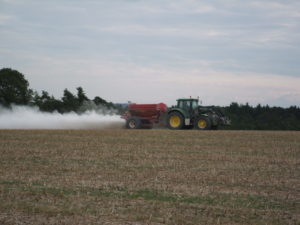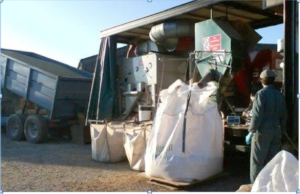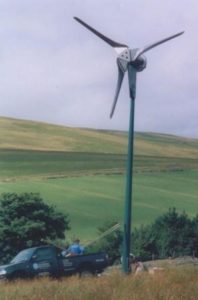View from the Hill 2nd February 2007
Today has been a beautiful, yet unseasonal day, warm sunshine pushing the temperature up to 15 degrees this afternoon, it is certainly giving mixed messages about everything. Should we worry that it’s all to do with global warming, or just enjoy it? Well I reckon we should do both. There’s no denying global warming if thousands of scientists are all saying it is fact, as they did in the UN report released this week that human activity, primarily the burning of millions of years worth of accumulated fossil fuels within a period of less than 100 years, is causing a measurable increase in average world temperatures. And predictions show that temperatures will continue to increase even if we manage to take serious measures immediately. There is a deluge of information in the press and on the web about what we can do as individuals, we can set an example to our neighbours and to the rest of the world. “Think Global, act local”. More about the wind turbine next month.
I have been perplexed by the recent allegations that cows and sheep are responsible for more greenhouse gas than nearly anything else. Surely they can only be burping and farting as much carbon into the atmosphere as they have acquired from the cellulose, sugars and starch that they have consumed as grass and grains in their diet. All of which, being plants, must have captured the carbon from the atmosphere in the first place. The ruminant stomach is not a kind of reverse black hole which can produce more carbon than it consumes. I understand that methane is a particularly effective greenhouse gas, but I don’t believe that it can approach the effect caused by the amount of fossil fuel burning that is going on around the world. In this country alone we burn around 50 million tonnes of petrol and diesel every year. Mostly in transport and heating.
 Closer to home, this week, as the ground has dried out so well, we have had chalk and fertiliser spread on many of our fields in preparation for spring crops of barley, beans, sunflowers, and perhaps borage and poppies. The ground chalk comes from a quarry near Salisbury, and we use it to counteract acidity on the clay cap soils on the farm, and the fertiliser is called Fibrophos, which is the ash by-product from power stations which burn chicken manure to produce electricity. It is quite high in phosphate and potash, two of the most important plant nutrients, as well as useful levels of sulphur, magnesium and other nutrients, all in a form that is more accessible to plants than some of the artificial fertilisers we have used in the past. The trouble with spreading chalk and fibrophos is that we do not have a machine suitable for this, so we employ a contractor. His tractor has a ‘sat-nav for fields’, which enables him to map the field by driving around the headland at the beginning, then the computer tells him the most efficient way of covering the field, and directs him to drive at the right spreading width for the spreader. Not only this, but it will even do the steering as well! He lets go of the steering wheel for each trip across the field, only grabbing it to turn at the ends. The gadget will drive the tractor more accurately than a human can, and doesn’t get tired, or distracted watching what’s going on over the hedge. It is really supposed to enable him to take more care with settings like speed, and ensuring the spreader is working properly.
Closer to home, this week, as the ground has dried out so well, we have had chalk and fertiliser spread on many of our fields in preparation for spring crops of barley, beans, sunflowers, and perhaps borage and poppies. The ground chalk comes from a quarry near Salisbury, and we use it to counteract acidity on the clay cap soils on the farm, and the fertiliser is called Fibrophos, which is the ash by-product from power stations which burn chicken manure to produce electricity. It is quite high in phosphate and potash, two of the most important plant nutrients, as well as useful levels of sulphur, magnesium and other nutrients, all in a form that is more accessible to plants than some of the artificial fertilisers we have used in the past. The trouble with spreading chalk and fibrophos is that we do not have a machine suitable for this, so we employ a contractor. His tractor has a ‘sat-nav for fields’, which enables him to map the field by driving around the headland at the beginning, then the computer tells him the most efficient way of covering the field, and directs him to drive at the right spreading width for the spreader. Not only this, but it will even do the steering as well! He lets go of the steering wheel for each trip across the field, only grabbing it to turn at the ends. The gadget will drive the tractor more accurately than a human can, and doesn’t get tired, or distracted watching what’s going on over the hedge. It is really supposed to enable him to take more care with settings like speed, and ensuring the spreader is working properly.
 We have been visited by our seed cleaning contractors this week, who have cleaned and bagged about 30 tons of our own beans and barley from last harvest, for sowing in the next couple of months. Testing of the seed showed that it was all free of disease, so does not need any seed dressing.
We have been visited by our seed cleaning contractors this week, who have cleaned and bagged about 30 tons of our own beans and barley from last harvest, for sowing in the next couple of months. Testing of the seed showed that it was all free of disease, so does not need any seed dressing.
Hedge trimming is progressing well in the dry weather. Most of our hedges are trimmed every 2 years now, because this encourages more fruit to set on the hedge plants in the second year, which is valuable winter bird food.
Back to February 2017

